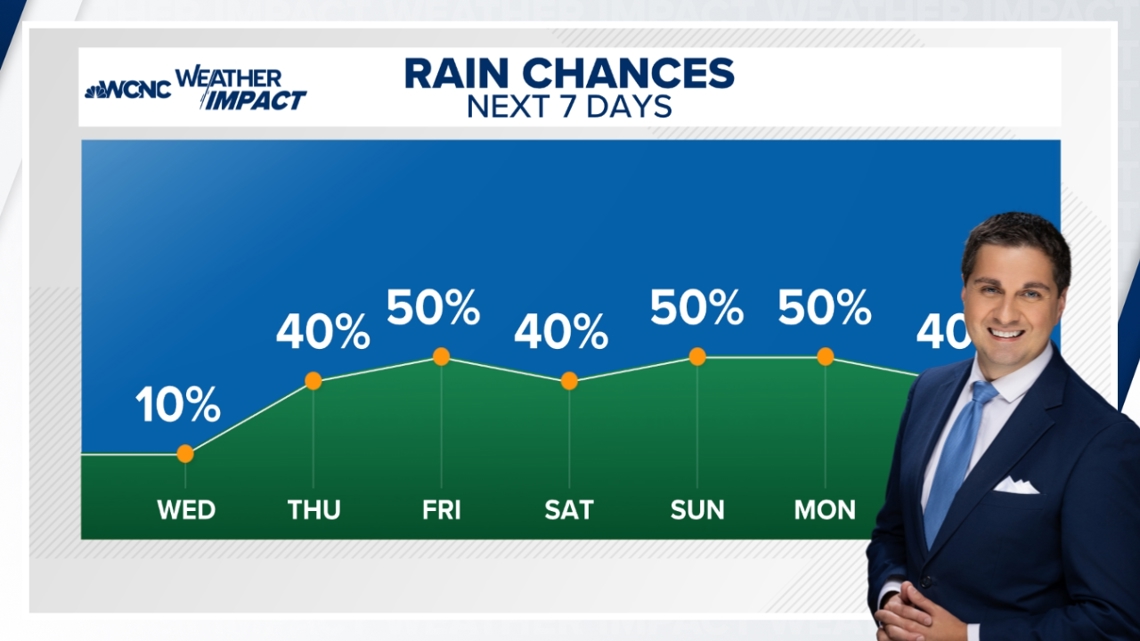Isolated vs. scattered showers: Know the difference

Meteorologists use “isolated” and “scattered” to describe rain coverage. Here is exactly what those terms mean.
CHARLOTTE, N.C. — Ever wondered why meteorologists use terms like “isolated” and “scattered” when talking about rain? You’re not alone! This is one of the most frequently asked weather questions, and understanding the difference can help you plan your day much better.
The Key Difference: It’s All About Coverage 📍
The main difference between isolated and scattered showers comes down to coverage — how much of your area is expected to get rain, not how hard it rains or for how long.
🌦️ Isolated Showers
- Coverage: 10-20% of the area
- What it means: Very few locations will see rain — most places stay completely dry
- Think of it as: “Hit-or-miss” showers where you might get lucky and avoid the rain entirely
- Planning tip: You probably don’t need an umbrella, but keep an eye on the sky
🌧️ Scattered Showers
- Coverage: 30-50% of the area
- What it means: More widespread than isolated, but still not everyone gets wet
- Think of it as: “Better have an umbrella handy, but it’s not a total washout”
- Planning tip: There’s a decent chance you’ll encounter some rain during the day
Understanding Rain Percentages: The PoP Formula
Those percentages you see in weather forecasts? They’re called PoP (Probability of Precipitation), and they represent the likelihood of getting measurable rain (at least 0.01 inches) in your area over a specific time period.
Here’s the meteorologist’s secret: PoP isn’t just a guess — it follows a formula:
PoP = Confidence × Coverage


Breaking Down Common Percentages
- Forecasters are 100% confident rain will occur, but only over 20% of the area
- This translates to isolated showers
- Most of us stay dry!
- Same confidence level, but rain covers more of the region
- This becomes scattered showers
- Think “4 out of 10 places like yours could see rain”
- Scattered showers become more likely than not
- Forecasters are very confident rain will hit more than half the area
- Good chance you’ll see rain, but dry spots will still exist
- Likely to numerous showers
- Forecasters are pretty certain it will rain over most of the region
- Time to have that backup plan for outdoor activities
- Forecasters are completely confident that measurable rain will fall somewhere in the forecast area
- Described as widespread rain
- Everyone in the area will likely be impacted at some point
Visualizing Rain Coverage 🗺️
Imagine your area divided into 5 equal sections:
- 20% (Isolated): Only 1 out of 5 sections gets rain
- 40% (Scattered): 2 out of 5 sections get wet, but you’re more likely to stay dry
- 60%: More than half the sections (3+ out of 5) see rain
- 80-100%: You’ll very likely get wet at some point during the day
Key Takeaways 💡
Important to remember: PoP percentages reflect both certainty and coverage, but have nothing to do with:
- How long it will rain
- How intense the rain will be
- What time of day it will rain
A 100% chance of rain could mean a brief 5-minute shower or a day-long soaking — the percentage only tells you how likely and widespread the rain will be, not its duration or intensity.
- Low percentages (10-30%): Isolated showers — most areas stay dry
- Medium percentages (40-60%): Scattered showers — some areas get wet
- High percentages (70-100%): Widespread rain — most areas will be impacted
Contact Chris Mulcahy at cmulcahy@wcnc.com and follow him on Facebook, X, Instagram and TikTok.
Come Raise Your Weather IQ


